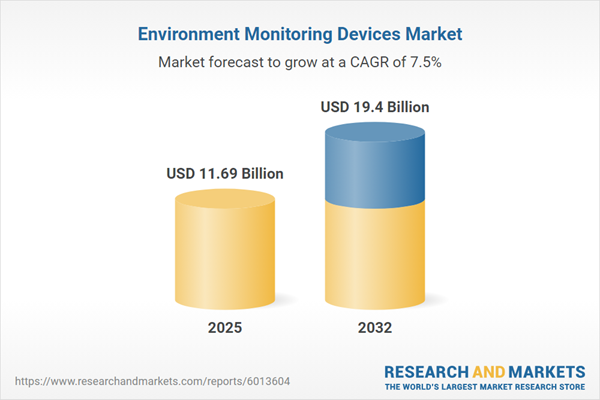Speak directly to the analyst to clarify any post sales queries you may have.
As sustainability and compliance take center stage globally, environment monitoring devices have become indispensable for organizations seeking to balance operational performance with environmental responsibility. In an evolving regulatory and technological landscape, understanding market drivers, challenges, and emerging opportunities is essential for strategic decision-making.
Market Snapshot: Environment Monitoring Devices
The Environment Monitoring Devices Market grew from USD 10.86 billion in 2024 to USD 11.69 billion in 2025. It is expected to continue growing at a CAGR of 7.52%, reaching USD 19.40 billion by 2032. This expansion reflects a rising global demand for advanced sensors, real-time analytics, and integrated monitoring solutions, driven by increasingly stringent regulations and stakeholder emphasis on sustainability and public health.
Scope & Segmentation
- Product Types: Air quality monitors (fixed, rack mounted, wall mounted, portable, battery powered, solar powered), noise monitoring devices (indoor handheld, wall mounted, outdoor standalone, vehicle mounted), radiation detectors (ionizing - beta, gamma; non-ionizing - microwave, UV), soil moisture sensors (capacitance, TDR, tensiometers), and water quality monitors (in situ fixed, portable, laboratory offline, online).
- Technologies: AI-driven systems (anomaly detection, predictive analytics), IoT-enabled platforms (cloud based, edge based), wired interfaces (Ethernet, RS 485, USB), and wireless solutions (Bluetooth, LoRa, NB IoT, Wi Fi).
- Applications: Agricultural management (irrigation scheduling, precision farming), air pollution control (indoor, outdoor), industrial emission monitoring (fugitive emission, stack monitoring), noise compliance (construction, transportation), and water treatment (potable, wastewater).
- End Users: Commercial offices and retail, government agencies and municipalities, industrial facilities (manufacturing, oil and gas, power generation), research settings (academic, private labs), and residential contexts (multi family, single family).
- Regions: Americas (North America – United States, Canada, Mexico; Latin America – Brazil, Argentina, Chile, Colombia, Peru), Europe, Middle East & Africa (Europe – United Kingdom, Germany, France, Russia, Italy, Spain, Netherlands, Sweden, Poland, Switzerland; Middle East – United Arab Emirates, Saudi Arabia, Qatar, Turkey, Israel; Africa – South Africa, Nigeria, Egypt, Kenya), Asia-Pacific (China, India, Japan, Australia, South Korea, Indonesia, Thailand, Malaysia, Singapore, Taiwan).
- Industry Leaders: Thermo Fisher Scientific Inc., Honeywell International Inc., Siemens AG, Emerson Electric Co., Schneider Electric SE, Teledyne Technologies Incorporated, ABB Ltd, Endress+Hauser AG, AMETEK, Inc., HORIBA, Ltd.
Key Takeaways
- Organizations are rapidly integrating AI-enabled and IoT-based platforms to enhance real-time monitoring, enable predictive maintenance, and improve compliance outcomes.
- Technological convergence enables proactive detection and operational interventions, transforming environment monitoring from a reactive function to a strategic asset across sectors.
- Regulatory evolution—especially in emissions, ecological assessments, and ESG commitments—is catalyzing demand for higher data transparency and continuous monitoring capabilities.
- End users span a wide array, from industrial and municipal operations to commercial and residential environments, making interoperability and modularity essential for scalable solutions.
- Regional factors—from cross-border procurement initiatives in the Americas, public-private partnerships in EMEA, to localized supply chain innovation in Asia-Pacific—shape adoption speeds and product customization requirements.
Tariff Impact: 2025 U.S. Trade Policy Developments
United States tariffs enacted in 2025 have increased supply chain costs for environment monitoring device manufacturers, prompting a strategic reassessment of sourcing, production, and risk management. In response, organizations are localizing key assembly operations, forming collaborative procurement groups, and pursuing tariff exemptions to safeguard competitiveness, resilience, and customer trust as regulatory scrutiny intensifies.
Methodology & Data Sources
This report applies a rigorous approach, combining systematic reviews of publicly available literature and technical data with expert interviews. Primary data from executives and product leaders was validated through triangulation and multiple peer reviews, ensuring the analysis blends quantitative benchmarks with nuanced market insights.
Why This Report Matters
- Gain actionable intelligence on product, technology, application, and user segment trends influencing procurement and innovation strategies in environment monitoring.
- Understand the interplay of regulatory changes, technological disruption, and international trade dynamics shaping market growth and risk mitigation tactics.
Conclusion
Adopting integrated, adaptive environment monitoring solutions will be crucial for organizations seeking resilience, compliance, and long-term sustainable growth. Comprehensive insight into market segments and strategic industry shifts positions stakeholders to harness future opportunities effectively.
Additional Product Information:
- Purchase of this report includes 1 year online access with quarterly updates.
- This report can be updated on request. Please contact our Customer Experience team using the Ask a Question widget on our website.
Table of Contents
3. Executive Summary
4. Market Overview
7. Cumulative Impact of Artificial Intelligence 2025
Companies Mentioned
The companies profiled in this Environment Monitoring Devices market report include:- Thermo Fisher Scientific Inc.
- Honeywell International Inc.
- Siemens AG
- Emerson Electric Co.
- Schneider Electric SE
- Teledyne Technologies Incorporated
- ABB Ltd
- Endress+Hauser AG
- AMETEK, Inc.
- HORIBA, Ltd
Table Information
| Report Attribute | Details |
|---|---|
| No. of Pages | 194 |
| Published | October 2025 |
| Forecast Period | 2025 - 2032 |
| Estimated Market Value ( USD | $ 11.69 Billion |
| Forecasted Market Value ( USD | $ 19.4 Billion |
| Compound Annual Growth Rate | 7.5% |
| Regions Covered | Global |
| No. of Companies Mentioned | 11 |









